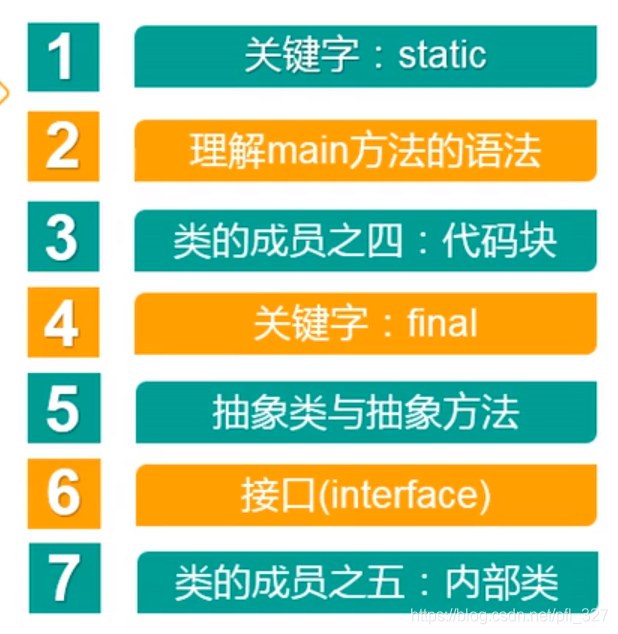社区微信群开通啦,扫一扫抢先加入社区官方微信群

社区微信群
社区微信群开通啦,扫一扫抢先加入社区官方微信群

社区微信群

三条主线:
1.类和类的成员:属性,方法,构造器,代码块,内部类
2.封装,继承,多态
3.其它关键字的使用(this,package,import,super,static,final,abstract,接口-Interface)






public class StaticTest {
public static void main(String[] args) {
Chinese.nation = "Chinese";
Chinese c = new Chinese();
c.name = "姚明";
c.age = 40;
Chinese c1 = new Chinese();
c1.name = "马龙";
c1.age = 30;
c.nation = "CHN";
System.out.println(c1.nation);
c1.eat();
Chinese.show();
}
}
class Chinese {
String name;
int age;
static String nation;
public void eat() {
System.out.println("中国人吃馒头");
}
public static void show() {
System.out.println("我是一个中国人!");
}
}

static的应用举例:
public class CircleTest {
public static void main(String[] args) {
Circle c1 = new Circle();
Circle c2 = new Circle();
Circle c3 = new Circle(3.4);
System.out.println("c1的id:" + c1.getId());
System.out.println("c2的id:" + c2.getId());
System.out.println("c3的id:" + c3.getId());
System.out.println("创建圆的个数为:" + Circle.getTotal());
}
}
class Circle {
private double radius;
private int id; //自动赋值
private static int total; // 记录创建圆的个数
private static int init = 1001; // static生命的属性被所有对象所共享
public Circle() {
id = init++;
total++;
}
public Circle(double radius) {
//有时构造对象是用的含参的构造器,记录的个数同样要加加
this(); //类似于调用了空参的构造器
// id = init++;
// total++;
this.radius = radius;
}
public double getRadius() {
return radius;
}
public void setRadius(double radius) {
this.radius = radius;
}
public int getId() {
return id;
}
public void setId(int id) {
this.id = id;
}
public static int getTotal() {
return total;
}
public double findArea() {
return 3.14 * radius * radius;
}
}





重写toString;
测试类:
应用:
经典的23中设计模式:

饿汉式-单例设计模式:

返回的是同一个对象;



单例设计模式的应用场景


通过main函数进行与控制台进行交互:
先正常编译运行一下;
接下来就是Run Configurations:

用命令行进行运行编译:

三条主线:
1.类和类的成员,属性,方法,构造器,代码块,内部类
2.封装,继承,多态
3.其它关键字的使用(this,package,import,super,static,final,abstract,接口-Interface)



小例子测试:
LeafTest.java:




Son.java:

此时的结果:
继续new一个Son的结果:
注释全部打开的结果:






每日一练:






public class AbstractTest {
public static void main(String[] args) {
//一旦Person类抽象了,就不可以实例化了
// Person p1 = new Person();
// p1.eat();
}
}
abstract class Person {
String name;
int age;
public Person() {
}
public Person(String name, int age) {
this.name = name;
this.age = age;
}
//这不是抽象方法(没有方法体的方法)
// public void eat() {
//
// }
//这是抽象方法
public abstract void eats();
public void eat() {
System.out.println("人吃饭!");
}
public void walk() {
System.out.println("人走路!");
}
}
abstract class Student extends Person {
public Student(String name, int age) {
//构造器的另外作用:依然可以被子类调用含参构造器
super(name,age);
}
//1.可以重写父类的所有方法来处理抽象方法
// public void eats() {
// System.out.println("学生们应该多吃营养食物!");
// }
//2.需要将这个子类置为抽象类
}



问题三答案:可以!




匿名类:




例:抽象类的应用:模板方法的设计模式
测试类:


应用二:






alt+shift+s:打开toString,get,set方法;
import java.util.Calendar;
import java.util.Scanner;
public class PayrollSystem {
public static void main(String[] args) {
//方式一
// Scanner scanner = new Scanner(System.in);
// System.out.println("请输入当月的月份:");
// int month = scanner.nextInt();
//方式二:
Calendar calendar = Calendar.getInstance();
int month = calendar.get(Calendar.MONTH); //获取当前的月份
System.out.println(month); //一月为:0
/*
*注:栈中有个变量是emps,指向堆空间造了一个数组,长度是2,
*每个位置声明成Employee类型 (数组元素暂时为抽象成类)
*/
Employee[] emps = new Employee[2];
//这才是多态
emps[0] = new SalariedEmployee("小明", 1002, new MyDate(1992, 2, 28),10000);
emps[1] = new HourlyEmployee("潘雨声", 2001, new MyDate(1991, 3, 6), 60, 240);
for(int i = 0;i < emps.length;i++) {
System.out.println(emps[i]);
double salary = emps[i].earnings();
System.out.println("月工资为:" + salary);
if( (month+1) == emps[i].getBirthday().getMonth()) {
System.out.println("生日快乐!奖励100元");
}
}
}
}
public abstract class Employee {
private String name;
private int number;
private MyDate birthday;
public Employee(String name, int number, MyDate birthday) {
super();
this.name = name;
this.number = number;
this.birthday = birthday;
}
public String getName() {
return name;
}
public void setName(String name) {
this.name = name;
}
public int getNumber() {
return number;
}
public void setNumber(int number) {
this.number = number;
}
public MyDate getBirthday() {
return birthday;
}
public void setBirthday(MyDate birthday) {
this.birthday = birthday;
}
public abstract double earnings();
@Override
public String toString() {
return "name=" + name + ", number=" + number + ", birthday=" + birthday.toDateString();
}
}
public class MyDate {
private int year;
private int month;
private int day;
public MyDate(int year, int month, int day) {
super();
this.year = year;
this.month = month;
this.day = day;
}
public int getYear() {
return year;
}
public void setYear(int year) {
this.year = year;
}
public int getMonth() {
return month;
}
public void setMonth(int month) {
this.month = month;
}
public int getDay() {
return day;
}
public void setDay(int day) {
this.day = day;
}
public String toDateString() {
return year + "年" + month + "月" + day + "日";
}
}
public class SalariedEmployee extends Employee {
private double monthlySalary;//月工资
//Employee没有空参的构造器,需要提供含有super(Employee)的构造器
public SalariedEmployee(String name, int number, MyDate birthday) {
super(name, number, birthday);
}
public SalariedEmployee(String name, int number, MyDate birthday, double monthlySalary) {
super(name, number, birthday);
this.monthlySalary = monthlySalary;
}
public double getMonthlySalary() {
return monthlySalary;
}
public void setMonthlySalary(double monthlySalary) {
this.monthlySalary = monthlySalary;
}
//有抽象方法,需要重写抽象方法--这样才能实例化
@Override
public double earnings() {
return monthlySalary;
}
@Override
public String toString() {
return "SalariedEmployee [" + super.toString() + "]";
}
}
public class HourlyEmployee extends Employee{
private int wage; //每小时的工资
private int hour; //月工作的小时数
public HourlyEmployee(String name, int number, MyDate birthday) {
super(name, number, birthday);
}
public HourlyEmployee(String name, int number, MyDate birthday, int wage, int hour) {
super(name, number, birthday);
this.wage = wage;
this.hour = hour;
}
public int getWage() {
return wage;
}
public void setWage(int wage) {
this.wage = wage;
}
public int getHour() {
return hour;
}
public void setHour(int hour) {
this.hour = hour;
}
@Override
public String toString() {
return "HourlyEmployee [" + super.toString() + "]";
}
@Override
public double earnings() {
return wage * hour;
}
}


类和接口是两个并列的结构,类中是单继承,一个类可以实现多个接口。可以解决类的单继承性 版权声明:本文来源CSDN,感谢博主原创文章,遵循 CC 4.0 by-sa 版权协议,转载请附上原文出处链接和本声明。
版权声明:本文来源CSDN,感谢博主原创文章,遵循 CC 4.0 by-sa 版权协议,转载请附上原文出处链接和本声明。
原文链接:https://blog.csdn.net/pfl_327/article/details/114034854
站方申明:本站部分内容来自社区用户分享,若涉及侵权,请联系站方删除。
如果觉得我的文章对您有用,请随意打赏。你的支持将鼓励我继续创作!
